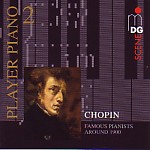Like MDG’s first Conlon Nancarrow volume, a Bösendorfer grand piano fit with an Ampico Player Piano Mechanism is used to reproduce the selection of Chopin piano-roll performances by pianists active in the medium’s heyday. While the limited range of dynamics, articulations, and tonal nuances give an incomplete impression of what these pianists sounded like (especially in comparison to flat discs), at least MDG’s playbacks yield steadier, less clunky results than Naxos’ Welte-Mignon series, if not matching the level of refinement distinguishing Ampico transfers such as L’Oiseau-Lyre’s early-1980s series (never on CD), or better still, Argo’s three-LP Golden Age of Piano Virtuosi, issued in the late 1960s.
Interestingly, the three opening selections featuring Liszt pupils (Eugen d’Albert’s Minute Waltz, Alfred Reisenauer’s Bolero, and Moriz Rosenthal’s Etude in Thirds Op. 25 No. 6) bear only a few traces of Romantic rhetoric, and may sound relatively straightforward and unremarkable to uninitiated listeners. The same goes for Mischa Levitzki’s “Black Key” and “Butterfly” etudes. At the same time, it’s difficult to reconcile the choppy, rhythmically mauled, and textually altered portions of Busoni’s First Ballade to his awesome reputation. And if Alfred Mirovich’s rolls are to be believed, he not only couldn’t play the B-flat minor Scherzo’s outer sections in rhythm, but he also slams down the pedal throughout most of the B-flat minor Sonata’s finale.
But we know that Leopold Godowsky didn’t play the A-flat Ballade’s opening section so slowly, loudly, metronomically, and unmusically as his roll reveals because his flat disc recording proves otherwise. In the Fourth Ballade, maverick composer/pianist Leo Ornstein cuts from the introduction’s end until the beginning of measure 23, and saves his straightest, least idiosyncratic, and most scintillating playing for the coda. To my ears, Mieczyslaw Munz’s grandiose, sweeping Revolutionary Etude (Op. 10 No. 12) is the most artistically convincing item here. In all, these problematic yet fascinating documents are bound to attract historic-minded pianophiles.
































